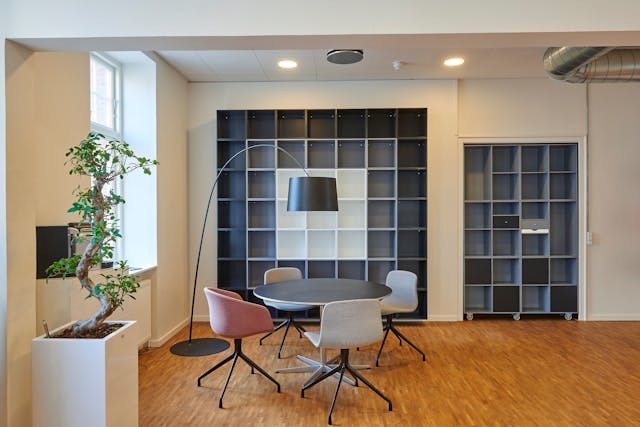Featured Image Caption: Round Black Wooden Table With 4-chairs
Jump to read...
Workplace safety is not an afterthought; it is a necessity. You are not merely protecting your employees, but you are also protecting your visitors. As a manager, it is your role to monitor every security measure under implementation. Safety in the office is an encompassing field, both physical and psychological. Once you create a safety culture, you create a culture of security, trust and collaboration. Thus, safety should continually be your priority, and it should be something that all your actions are based on throughout your career.
Clear Emergency Procedures
Having clear emergency protocols is important in keeping your office safe. You should post fire evacuation plans in each room and conduct regular drills for emergencies like quakes. Ensure that all people see and understand the clear signs that signal the way out during an emergency. Train your employees in such protocols continuously so that they will be conversant with what to do in case of trouble. During a crisis, it would save lives to design easy steps easy to remember and follow. It is important that these instructions be simple to grasp by the employees.
Fire Safety Readiness
Fire safety starts with good planning and having the right tools to extinguish fires. You should have fire extinguishers placed in every optimum station where employees can safely grab them when there’s a fire. Install smoke alarms to detect electronic sparks early and properly maintained sprinkler systems should trigger fire suppression. Train your staff on how to use the equipment and sound evacuations during a fire. Inspections should be done often to guarantee that these tools always work. Upkeeping these practices may protect your building and save lives.
Electrical Safety Checks
Electrical safety is an ordinary yet significant business that determines the reliability of security. You should never allow circuit overload, and if it happens, you should assist in a power balancing act along the circuits. Periodically check your wiring and maintain loose outlets and cables. Use electrical appliances properly as per the manufacturer’s instructions and use safety measures. In case you notice any defective equipment, inform a professional to prevent the occurrence of any further incidents. Scheduled inspections ensure that your electrical systems work seamlessly, and your business continues safely.
Secure Entry and Exit Points
Physical entry and exit points are the windows to building safety. Control who enters your building by having security guards or cameras ready at the entrances. Make sure that all visitors sign in and provide an appropriate identification in advance. Also, maintain the exits to be bright and lit up to be visible during the day and night. Lock back doors and access to sensitive areas. Maintain access points and openings to make sure that no one is impeded from moving out of the building. There may be no reason to be unprotected in areas that you can control.
Using Modern Security Tools
Modern security tools make your building substantially more secure. You should make considerable investments in intelligent commercial access control systems that can track movements in and out of a building daily. These systems can generate logs of who enters when they arrive and leave the building. This technology enables you to keep a check on sensitive areas and it also prevents entry as needed. It is not only about security, it is about employing a technology that allows you to rest easily. It will make your working environment safer and develop confidence in both employees and executives.
Health and First Aid Preparedness
Health emergencies should always be prepared at your office. To begin with, first-aid kits should be properly available and always kept. Ideally, have at least two trained first aid responders per floor. Furthermore, keep the emergency medical numbers posted in all areas. Record all the health incidents including mild cases. Lastly, label safety signs indicating the place where the first-aid kits are. Your team will be better placed to respond to health incidents in time due to thorough planning.
Safe Workspaces and Furniture
Creating a secure workspace is about ergonomics and a clutter-free atmosphere. Buying adjustable desks and chairs promotes correct posture and comfort which is very important. Secure all shelves and stored things to prevent tipping over which would hurt someone. Exit ways should always be kept clear and never be utilized as a storage area. Regularly checking your company layout will guarantee that there are no concealed trip and fall dangers. A simple redesign of a workstation layout can minimize the danger of injury to your employees at work.
Regular Building Maintenance
Regular building maintenance serves as the protection plan that is unseen. You need to pay close attention to all elevator and escalator systems by keeping them in good working condition. The heating, ventilation, and air conditioning systems should also be in good shape so that they do not pose health risks. Never ignore a mighty roofing structure; email repairs in a hurry. In this manner, you will avoid future problems like leaks or mold development which can be very expensive and unhealthy. Timely building maintenance will make your workplace safe and operational.
Safety Training for Employees
Training your employees on safety will make safety a shared responsibility. You can begin with workshops that will teach them about workplace safety matters. Providing every worker with a clear safety manual, statement, or handbook will help each of them know what to do. Culture should be created to report any hazards noticed. Not only ensure that your employees are safety conscious but also make sure that they cooperate to make the workplace safe. Constant training keeps them on their alert and available to take action at any moment.
Strong Communication Systems
Good communication is a bridge to a safe workplace during emergencies. Your chosen technology should allow you to send immediate emergency alerts to all staff in minutes. Internal communication tools are useful when emergencies are communicated very quickly. It is essential to have clearer procedures in place on what to do and who to contact. New policies or changes in safety plans should also be disseminated among others on a regular basis. Both the management and employees should communicate freely so that all the individuals are on the same page.
Conclusion
Safety in the workplace is not simply a one time initiative. As a manager, creating a safety atmosphere is a powerful example that your employees will follow. All your employees will feel more secure and work more efficiently because of this model. It is due to the active preventive actions that you will be ready to deal with threats, as well as reduce casualties. A secure office is able not only to protect lives, but also to make sure that the work is done productively. Thus, revise and improve your safety systems continuously; they will pay off in the long run for the entire company.
By Tracie Johnson
who is a New Jersey native and an alum of Penn State University. She is passionate about writing, reading, and living a healthy lifestyle. She feels happiest when around a campfire surrounded by friends, family, and her Dachshund named Rufus.
Member since April, 2025
View all the articles of Tracie Johnson.



















Leave a Reply